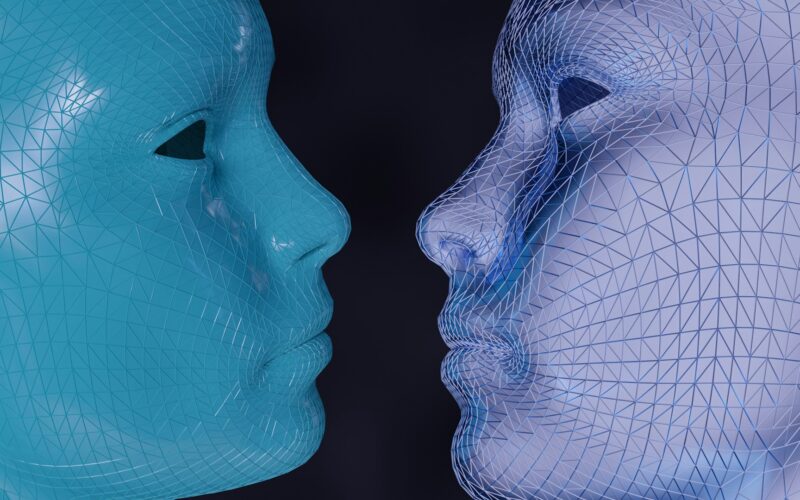I am pretty sure that you all, at least some times in your life, must have felt that you are being watched or heard. Not by a person, but by something more pervasive and indiscernible? These invisible forces decide what gets seen, what gets engagement, and ultimately, which brands win. I am meaning smartphones in your pockets and around you– that have become a force to reckon with.
Whether it’s TikTok’s For You Page, Instagram’s engagement-driven feed, or YouTube’s recommendations, one reality that should hit our minds straightaway is ‘smartphones have intruded into our lives and AI, of course as an indispensable part of it, is largely shaping brand identities more than brands themselves’.
Branding coupled with AI has lately become pretty generic, thereby lacking the nuanced understanding of a brand’s core values that a human designer or brand strategist inherently possesses. And it’s a matter of concern and discussion.
So, how can brands stay creative, competitive, and visible while utilizing AI? Or has AI taken over all the control of brands that they had over the marketing of yesteryears? We’ll see that in the article.
Proven Systems for Business Owners, Marketers, and Agencies
→ Our mini-course helps you audit and refine an existing brand in 15 days, just 15 minutes a day.
→ The Ultimate Brand Building System is your step-by-step blueprint to building and scaling powerful brands from scratch.
Table of Contents
Branding- Now vs. Then
The world of modern branding has considerably changed. With it have come algorithms that have somehow become the silent and dominant curators of our digital experiences. These days, a brand’s identity isn’t just built in boardrooms— it is sculpted by data trails and the algorithm’s invisible hand. One viral TikTok or an Instagram reel, and suddenly, a small brand goes from nobody to everywhere, all thanks to the algorithm picking it up.
In this vast and oddly unfamiliar landscape, branding itself seems to have blurred at the edges, morphing into something more reactive than intentional— a vague silhouette shaped less by vision and more by AI-driven currents.
Today, branding appears less about crafting a feeling and more about catching the algorithm’s eye. Brands today utilize AI and often sprint after trends, not timelessness, thereby trading depth for virality. In the race to stay relevant, that quiet magic— the kind that once made us pause, smile, or even tear up— has started to fade. Algorithms are reshaping branding by deciding what content gets seen, forcing brands to optimize for visibility over authenticity, often betting on trends instead of telling meaningful stories and establishing a connection with the target market.
Previously, brands were about stories, connections, and those magical moments that made you feel something. Like the Indian Dairy Milk ad from the 1990s, where a girl came dancing onto the cricket field, celebrating pure joy with the music “kuch khaas hai zindagi me” (life is special) playing in the background.
Or the Fevicol ad, where people clung to a bus so tightly, they might as well have been glued. Thinking of such ads in today’s era might sound old school, but brands had authority back then. They invoked feelings and took viewers closer to the purchase. They commanded branding and all of its aspects, which is why these ads worked for them. I’ll break down how it went.
- They told stories, not sold products. You didn’t just see chocolate or glue— you felt happiness, humor, and a strong sense of connection
- They were highly and deeply relatable. Cricket fever? Crowded buses? Every person had lived those moments in and out.
- They created stuff that invoked emotions first and recall second. You remembered the feeling long before the brand name. Many of us might remember the “Raymond—the complete man” tagline with its signature tune, which gave us a glimpse into how a complete man should be—elegant, responsible, well-dressed, but well-rounded.
- They were simple but unforgettable. Less celebrity involvement, and no gimmicks— just a bunch of ideas that pretty effectively stuck with the majority.
No fancy effects. No public figure endorsements. Just real emotions, simple storytelling, and ads that somehow stayed with you. Recalling that, right?
Branding these days? I’d say it’s largely driven by AI and its suite of tools, engagement rates, and getting after trends.
Having said that, it’s not that modern businesses always lack that emotional connection; they are overpowered by the sheer creativity and ingenuity of AI tools that shape branding experiences today. In fact, some critical observers have expressed concerns over AI’s impact on human creativity—a characteristic peculiar to competitive and growth-obsessed brands.
Consider an example of Coca-Cola’s controversial AI-generated holiday ad that drew flak from people worldwide, with a viewer dubbing it as the “most soulless commercial possible”. The U.S. Sun writes, “A leading marketing expert, Mara Einstein, views this ad as ‘cold and ineffective’, categorizing it as ‘so fake’ that it would not work to draw people into the brand.
From what I’ve perceived of the modern branding landscape, it is getting increasingly defined by invisible lines of code and cloaked instructions that determine who sees what, when, how, and why. If this is to be true, we’ll always question how real and emotionally binding such AI gimmicks are and the branding that follows as a result of such algorithms that are largely derived from user interactions and experience.
The Invisible Architects
Have you ever thought about what draws you to your favorite go-to brands? Is it their carefully crafted message, or something more nuanced? Today, that connection is increasingly mediated by algorithms that work behind the scenes, sorting, filtering, and presenting content with a tremendous level of precision.
Social media platforms have become more than just communication channels. They have established themselves as amplification engines. The reason I strongly feel this is its complex ecosystem make up where every like, share, and comment feeds into an intricate system that dramatically decides a brand’s fate. It’s akin to a digital popularity contest, but the judges are lines of code and complex algorithms instead of people.
The Future of Branding: Where Data Meets Emotion
Imagine having a friend who knows exactly what you want before you do. That’s AI-driven prediction in a nutshell. Businesses aren’t just tracking trends anymore— they anticipate them, sometimes with eerie accuracy. But here’s the thing: these aren’t lifeless, robotic guesses. They are precise insights pulled from billions of human interactions, almost like digital intuition. It’s important to note here that brands today can understand their audience in ways that would’ve been unthinkable just a few years ago. It’s fascinating indeed, and maybe a little unsettling.
At the same time, in a world ruled by AI algorithms, authenticity is becoming more important than ever. People can spot fake, soulless content in seconds, as discussed in Coca-Cola’s example. It’s crucial to understand that modern day brands winning right now aren’t just gaming the system; they are using technology to connect with people in a way that feels real. But the whole equation can get tricky at times. If your content feels too calculated, it loses its soul. If it’s too random, it gets lost in the noise. The real branding work happens in that perfect middle ground— where data helps shape content, but the heart still leads the way.
Telling Stories That Matter
Branding used to be about storytelling. Now, it’s about telling stories that algorithms actually want to share. Short, snappy, and straight to the point— that’s the new language of the internet. But the best brands know how to be concise without losing depth. Think of it like a tweet that stops you in your tracks or a headline that instantly makes you feel something. That’s what wins in today’s digital world. There is no denying the fact that brands love content that sparks an immediate emotional response, but the key is “the emotion has to be real”.
Like how Nike uses AI and algorithms about user behavior and preferences to do more than just sell shoes— it’s completely reimagining how people talk to and connect with the brand. From Nike Fit, which helps people find their perfect size with just a phone scan, to personalized shopping in apps and stores, everything is smarter, faster, and tailored to you. With smart acquisitions like Zodiac and Datalogue, Nike has turned data into real-time insights that make your shopping experience feel personal, not pushy. These acquisitions are hailed and deemed as sensible investments by the leading global sportswear brand.
And they are not stopping there. Projects like AIR (athlete imagined revolution) use generative AI and athlete data to design custom gear that performs as good as it looks. Even their ads are smarter— like the AI-powered chatbot in South Korea that helps shoppers pick the right pair. For Nike, AI isn’t just a tech upgrade— it’s a creative partner, helping them deliver more meaningful, personal, and exciting experiences at every step. Nike’s sensible approach towards AI has certainly given it an edge over its competitors which has further significantly boosted customer engagement and reinforced brand loyalty.
For all the talk about AI and automation, human emotion is still at the core of everything. Technology can help us better understand each other, but it will never replace the need for genuine connection. Algorithms are just tools. They can make us more precise, more targeted, and more insightful. But the creativity, the spark, the raw emotion? That’s still 100% human.
What’s Next: Using AI Subtly To Project Your Brand
AI isn’t your competitor— it’s a tool that can complement marketing beautifully. But to keep branding human, businesses need to play smart, sensible and be more natural. Let’s see how brands can leverage AI to make the most of it.
1. Let AI Assist, Not Dictate
AI can tell you what’s trending so that you may sensibly exploit it to your advantage. This means giving AI limited control so that it doesn’t decide your brand’s voice. Of course, brands can use data for insights, but the idea is to let humans craft the message. If AI suggests a viral thing or trend, make it yours with a personal twist- something users may strongly relate to.
2. Blend Emotional Storytelling with Al’s Growing Appeal
Short-form content wins online, but emotions make it stick. Use AI and hook with an engaging start, then bring in storytelling that actually means something for the immediate target audience and prospects at large. It’s vital for brands to keep notifying themselves consistently that people remember feelings, not just flashy trends.
3. Prioritize Authenticity Over Engagement Hacks
Gaming AI and its algorithm for reach is tempting, but forced content feels fake and concocted. Brands should stay real— something that contemporary consumers notice distinctly. Build relationships over quick wins. Brands that resonate get shared naturally.
4. Use AI to Personalize, Not Manipulate
Strong brand building is never a game of manipulation, but personalization. Knowing that AI can predict what people like, companies must use the input wisely. Instead of just selling, you may create experiences tailored to people’s needs and what the customers expect from you, thereby making them feel understood, not just targeted. The real strength of branding isn’t choosing between AI and emotion— it’s merging the two beautifully.
Wrapping Up
It’s great that brands are learning to integrate AI by constantly adapting to technological advancements, but the soul of branding demands emotional connection— the one that existed years back where people could see through and feel glad about their relationship with brands.
This goes without saying that the most exciting brands are not those that perfectly game the system, but those that master ingenuity to become more authentically themselves. They use AI to connect more deeply and to understand and express themselves as brands more clearly. As for brands of the modern era, it’s about finding the perfect harmony between human creativity and algorithmic insights.








